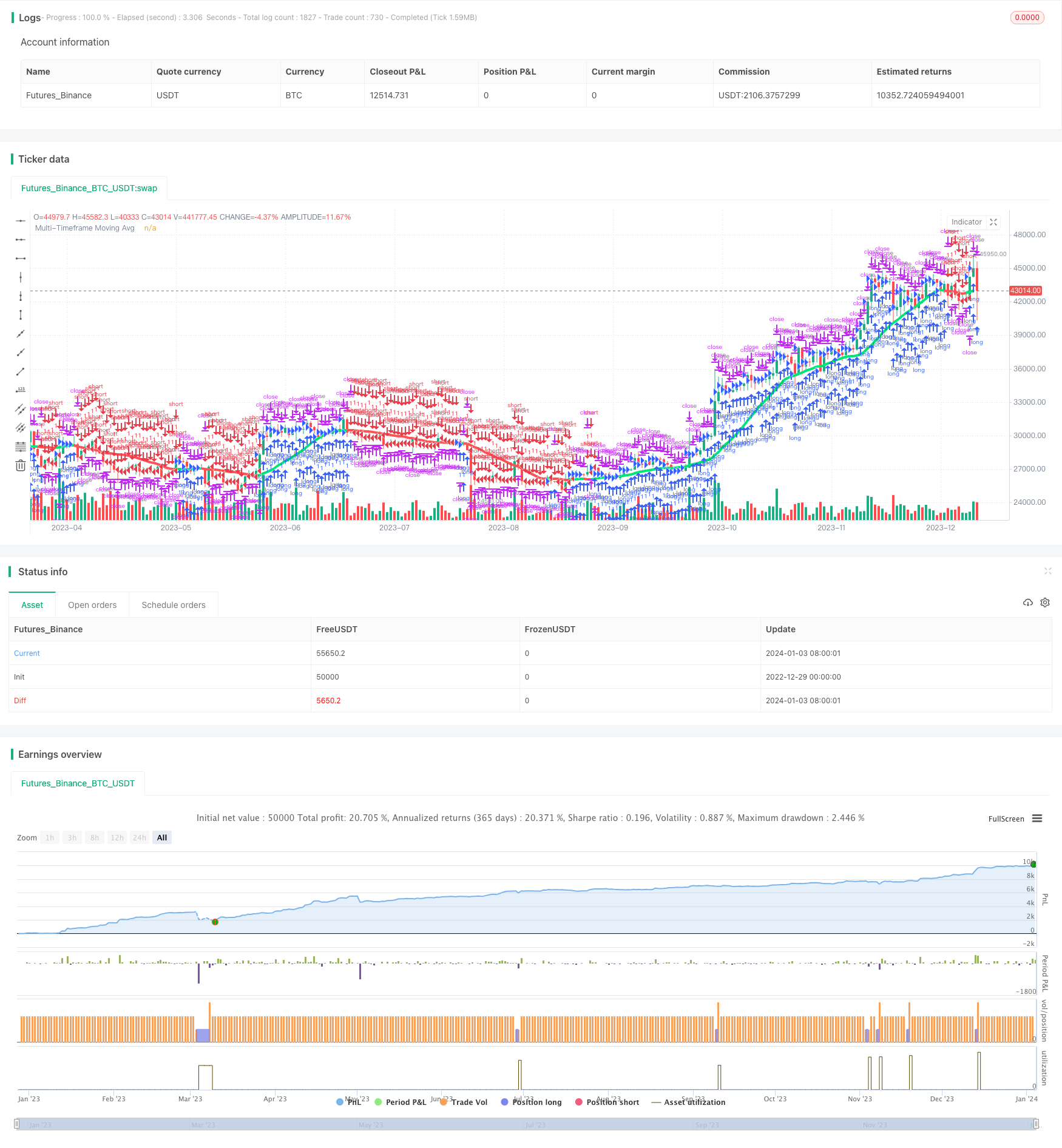Estratégia de otimização de crossover de escala multitemporal de média móvel
Data de criação:
2024-01-05 12:05:42
última modificação:
2024-01-05 12:05:42
cópia:
0
Cliques:
719
1
focar em
1621
Seguidores

Visão geral
A estratégia é baseada na reescrita do famoso indicador CM_Ultimate_MA_MTF, que permite traçar médias móveis em várias escalas de tempo, permitindo a operação cruzada de MA em diferentes períodos de tempo. A estratégia também possui uma função de stop loss tracking.
Princípio da estratégia
- Dependendo da escolha do usuário, os diferentes tipos de indicadores de MA podem ser usados para traçar as linhas de MA no gráfico principal e em períodos superiores.
- Quando a linha de MA de ciclo rápido atravessa a linha de MA de ciclo lento, faça mais; quando a linha de MA de ciclo rápido atravessa a linha de MA de ciclo lento, faça vazio.
- Adição de um mecanismo de rastreamento de stop loss para controlar ainda mais os riscos.
Análise de vantagens
- O cruzamento MA de várias escalas de tempo pode melhorar a qualidade do sinal e reduzir o falso sinal.
- A combinação de diferentes tipos de MA pode aproveitar as vantagens de seus respectivos indicadores para aumentar a estabilidade.
- O rastreamento de perdas ajuda a travar perdas em tempo hábil e reduz a probabilidade de perdas significativas.
Análise de Riscos
- Os indicadores de MA estão atrasados e podem ter perdido a oportunidade de uma operação de linha curta.
- É necessário otimizar adequadamente os parâmetros do ciclo MA, caso contrário, pode-se gerar um excesso de falso sinal.
- A configuração imprudente do ponto de parada pode causar perdas desnecessárias.
Direção de otimização
- É possível testar combinações de MA de diferentes parâmetros para encontrar o melhor parâmetro.
- Pode ser adicionado filtro de outros indicadores para melhorar a qualidade do sinal.
- A estratégia de stop loss pode ser otimizada para se adequar melhor às características do mercado.
Resumir
A estratégia integra a análise de múltiplos quadros temporais de médias móveis e métodos de rastreamento de stop loss, com o objetivo de melhorar a qualidade do sinal e controlar o nível de risco. A eficácia da estratégia pode ser aumentada ainda mais com a otimização de parâmetros e a adição de outros indicadores.
Código-fonte da estratégia
/*backtest
start: 2022-12-29 00:00:00
end: 2024-01-04 00:00:00
period: 1d
basePeriod: 1h
exchanges: [{"eid":"Futures_Binance","currency":"BTC_USDT"}]
*/
//@version=2
strategy(title = "Ultimate Moving Average Strategy", shorttitle = "UMA Strategy", overlay = true)
//Created by user ChrisMoody 4-24-2014
//Converted to strategy by Virtual_Machinist 7-11-2018
//Plots The Majority of Moving Averages
//Defaults to Current Chart Time Frame --- But Can Be Changed to Higher Or Lower Time Frames
//2nd MA Capability with Show Crosses Feature
//inputs
src = close
useCurrentRes = input(true, title="Use Current Chart Resolution?")
resCustom = input(title="Use Different Timeframe? Uncheck Box Above", defval="D")
len = input(20, title="Moving Average Length - LookBack Period")
atype = input(1,minval=1,maxval=7,title="1=SMA, 2=EMA, 3=WMA, 4=HullMA, 5=VWMA, 6=RMA, 7=TEMA")
cc = input(true,title="Change Color Based On Direction?")
smoothe = input(2, minval=1, maxval=10, title="Color Smoothing - 1 = No Smoothing")
doma2 = input(false, title="Optional 2nd Moving Average")
len2 = input(50, title="Moving Average Length - Optional 2nd MA")
atype2 = input(1,minval=1,maxval=7,title="1=SMA, 2=EMA, 3=WMA, 4=HullMA, 5=VWMA, 6=RMA, 7=TEMA")
cc2 = input(true,title="Change Color Based On Direction 2nd MA?")
warn = input(false, title="***You Can Turn On The Show Dots Parameter Below Without Plotting 2nd MA to See Crosses***")
warn2 = input(false, title="***If Using Cross Feature W/O Plotting 2ndMA - Make Sure 2ndMA Parameters are Set Correctly***")
sd = input(false, title="Show Dots on Cross of Both MA's")
useStop = input(defval = true, title = "Use Trailing Stop?")
slPoints = input(defval = 200, title = "Stop Loss Trail Points", minval = 1)
slOffset = input(defval = 400, title = "Stop Loss Trail Offset", minval = 1)
res = useCurrentRes ? timeframe.period : resCustom
//hull ma definition
hullma = wma(2*wma(src, len/2)-wma(src, len), round(sqrt(len)))
//TEMA definition
ema1 = ema(src, len)
ema2 = ema(ema1, len)
ema3 = ema(ema2, len)
tema = 3 * (ema1 - ema2) + ema3
avg = atype == 1 ? sma(src,len) : atype == 2 ? ema(src,len) : atype == 3 ? wma(src,len) : atype == 4 ? hullma : atype == 5 ? vwma(src, len) : atype == 6 ? rma(src,len) : tema
//2nd Ma - hull ma definition
hullma2 = wma(2*wma(src, len2/2)-wma(src, len2), round(sqrt(len2)))
//2nd MA TEMA definition
sema1 = ema(src, len2)
sema2 = ema(sema1, len2)
sema3 = ema(sema2, len2)
stema = 3 * (sema1 - sema2) + sema3
avg2 = atype2 == 1 ? sma(src,len2) : atype2 == 2 ? ema(src,len2) : atype2 == 3 ? wma(src,len2) : atype2 == 4 ? hullma2 : atype2 == 5 ? vwma(src, len2) : atype2 == 6 ? rma(src,len2) : tema
out = avg
out_two = avg2
out1 = request.security(syminfo.tickerid, res, out)
out2 = request.security(syminfo.tickerid, res, out_two)
ma_up = out1 >= out1[smoothe]
ma_down = out1 < out1[smoothe]
col = cc ? ma_up ? lime : ma_down ? red : aqua : aqua
col2 = cc2 ? ma_up ? lime : ma_down ? red : aqua : aqua
circleYPosition = out2
plot(out1, title="Multi-Timeframe Moving Avg", style=line, linewidth=4, color = col)
plot(doma2 and out2 ? out2 : na, title="2nd Multi-TimeFrame Moving Average", style=circles, linewidth=4, color=col2)
plot(sd and cross(out1, out2) ? circleYPosition : na,style=cross, linewidth=5, color=yellow)
// Strategy conditions
longCond = ma_up
shortCond = ma_down
// entries and base exit
strategy.entry("long", strategy.long, when = longCond)
strategy.entry("short", strategy.short, when = shortCond)
if (useStop)
strategy.exit("XL", from_entry = "long", trail_points = slPoints, trail_offset = slOffset)
strategy.exit("XS", from_entry = "short", trail_points = slPoints, trail_offset = slOffset)
// not sure needed, but just incase..
strategy.exit("XL", from_entry = "long", when = shortCond)
strategy.exit("XS", from_entry = "short", when = longCond)